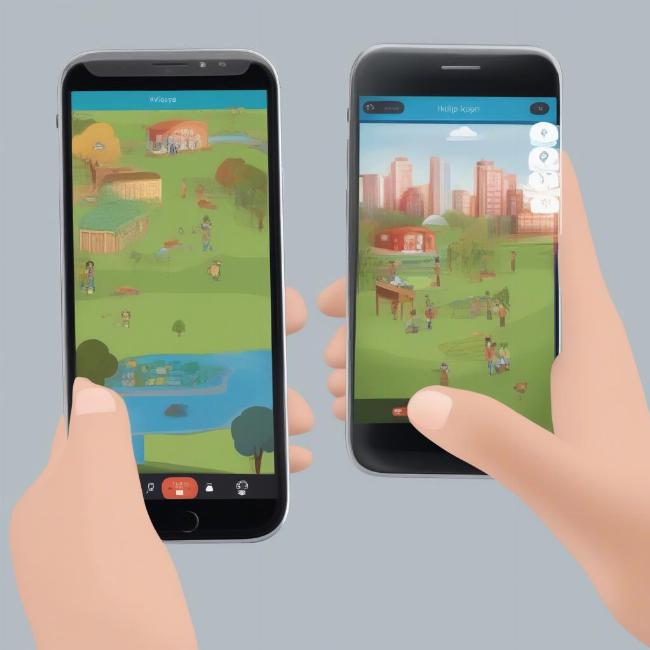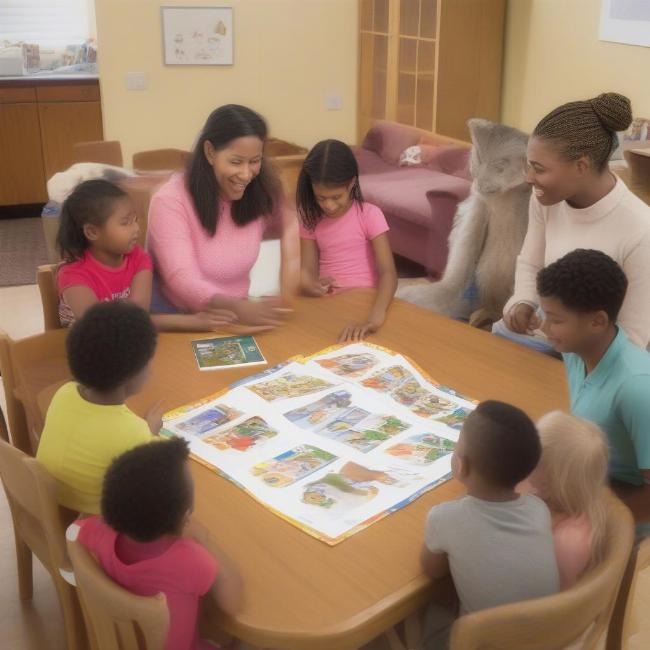What and Where is a classic English vocabulary game that challenges your descriptive powers and spatial reasoning. It’s a simple yet effective way to enhance your English skills, whether you’re a beginner or an advanced learner. This game offers a fun and interactive way to expand your vocabulary, improve your sentence construction, and boost your overall communication skills in English.
Understanding the “What and Where” Game
The “What and Where” game focuses on identifying and describing objects within a given space. One player thinks of an object within a defined area (like a room, a picture, or even a whole city). The other players then ask questions about the object’s location, using only “where” questions, and about its attributes, using only “what” questions. This back-and-forth continues until someone correctly guesses the object. For example, imagine the object is a lamp in a living room. Players might ask, “Where is it? Is it near the window?” or “What is it? Is it something you read with?” Through these questions, players narrow down the possibilities and eventually identify the hidden object.
trò chơi what and where combines elements of deduction, description, and vocabulary building, making it a valuable tool for English language learning.
 Trò chơi What and Where trong lớp học
Trò chơi What and Where trong lớp học
Boosting Your English Vocabulary with “What and Where”
The game provides a dynamic platform to learn and apply new words in context. When describing objects, players are encouraged to use descriptive adjectives, prepositions of place, and other vocabulary related to location and characteristics. This active recall strengthens vocabulary retention and improves fluency. For instance, instead of just saying “It’s a chair,” a player might say, “It’s a wooden rocking chair located near the fireplace.” This detailed description not only helps other players guess the object but also reinforces the player’s understanding and usage of specific vocabulary. The more you play, the more you’ll find yourself reaching for richer and more precise language.
Honing Your Questioning Skills in English
Asking the right questions is crucial in “What and Where.” The game inherently promotes the formulation of clear and concise questions in English. Players must think strategically about what information they need to elicit and how to phrase their questions effectively. This practice improves question formation and comprehension, essential skills for everyday communication. Are you looking for a fun way to improve your English? Check out trò chơi what and where.
 Học sinh chơi What and Where trên điện thoại
Học sinh chơi What and Where trên điện thoại
Adapting “What and Where” for Different Levels
The beauty of this game lies in its adaptability. It can be tailored to suit various proficiency levels. Beginners can start with simple objects and locations within a familiar setting. As their vocabulary grows, they can move on to more complex scenarios. Advanced learners can incorporate more nuanced vocabulary, idiomatic expressions, and even cultural references to make the game more challenging. For example, beginners might focus on describing objects in a kitchen, while advanced learners might describe landmarks in a city or characters in a painting.
“What and Where”: Beyond the Classroom
While commonly used in educational settings, the “What and Where” game isn’t confined to classrooms. It’s an excellent activity for families, friends, and even colleagues looking to improve their English in a relaxed and engaging environment. Playing the game regularly can contribute significantly to language development and foster a deeper appreciation for the nuances of English. Moreover, the game can be adapted for online platforms, making it accessible to learners around the world.
The Power of Visual Aids in “What and Where”
Incorporating visual aids can significantly enhance the learning experience. Using pictures, maps, or even real-life objects adds a visual dimension to the game, making it more interactive and memorable. Visual cues help learners associate words with their corresponding images, facilitating vocabulary acquisition and retention. This also makes the game more appealing to visual learners. Learn more about improving your vocabulary with trò chơi what and where.
 Gia đình chơi What and Where
Gia đình chơi What and Where
Taking the “What and Where” Game to the Next Level
Integrating technology can transform the traditional “What and Where” game into a more interactive and personalized learning experience. Mobile apps and online platforms offer a wealth of resources, including interactive maps, virtual environments, and pre-made vocabulary lists. These tools can add an element of gamification and make learning more fun and engaging, especially for younger learners. Consider using these tools to enhance the traditional game and make it even more effective.
Conclusion
The “What and Where” game is a valuable tool for anyone seeking to improve their English language skills. Its adaptability, combined with its engaging format, makes it a fun and effective way to build vocabulary, enhance communication, and boost confidence in using English. Whether you’re a beginner or an advanced learner, incorporating the “What and Where” game into your learning routine can significantly impact your English language proficiency. So, gather your friends, family, or classmates and start playing!
FAQ
-
What is the main objective of the “What and Where” game? The main objective is to guess a hidden object by asking “what” and “where” questions.
-
Can I play “What and Where” online? Yes, there are online platforms and mobile apps that offer digital versions of the game.
-
Is this game suitable for all English proficiency levels? Yes, the game can be adapted to suit beginners, intermediate learners, and advanced learners.
-
What are the benefits of playing “What and Where”? It improves vocabulary, sentence construction, questioning skills, and overall communication in English.
-
Can I use visual aids with this game? Absolutely, visual aids like pictures and maps can enhance the learning experience.
-
How can I make the “What and Where” game more challenging? Introduce more complex vocabulary, idiomatic expressions, and cultural references.
-
Is “What and Where” only for classroom use? No, it can be enjoyed by families, friends, and colleagues in any setting. trò chơi what and where can be a fun activity for everyone.